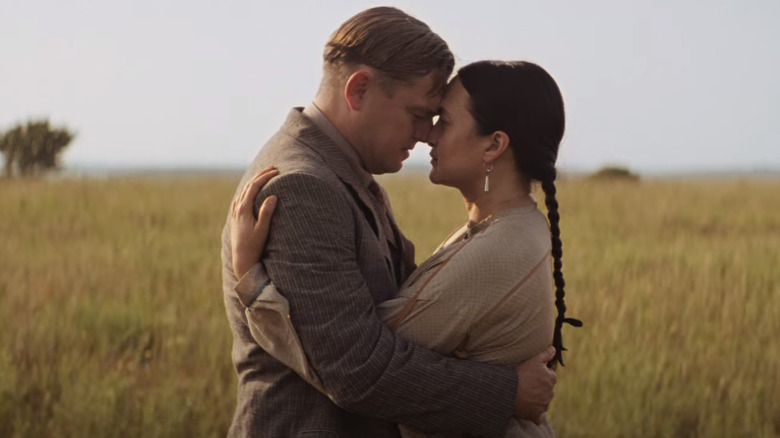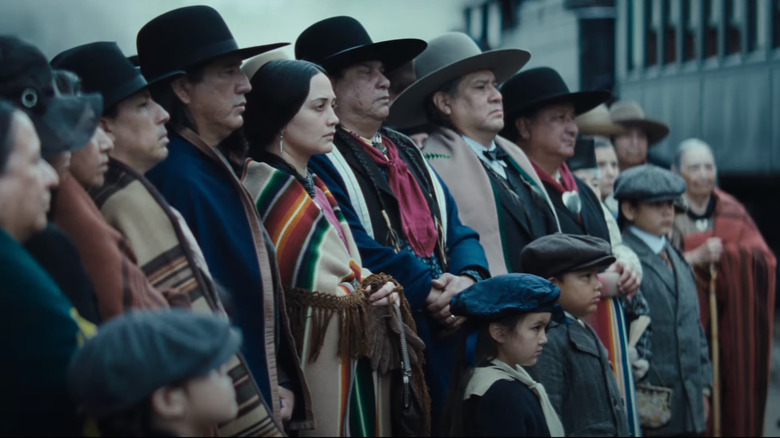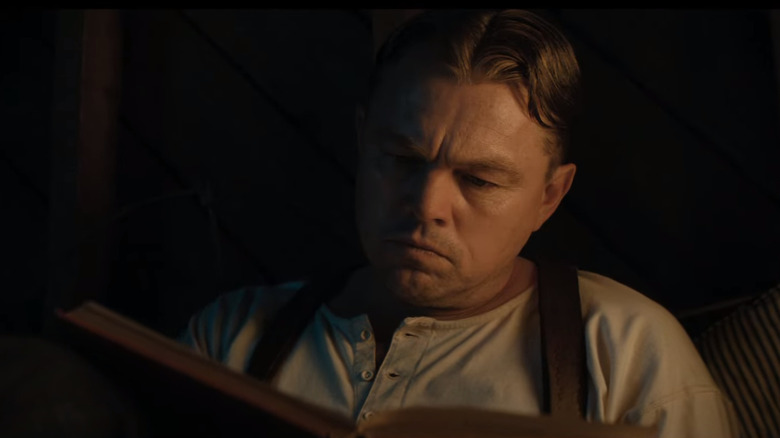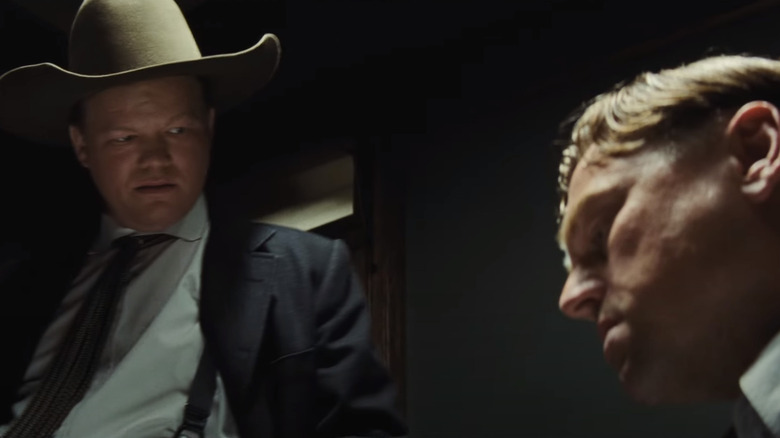The True Story Behind Martin Scorsese's Killers Of The Flower Moon
Director Martin Scorsese has made some truly brilliant art out of the dark corners of human history, from "Gangs of New York" to "Silence," but "Killers of the Flower Moon" looks like it might be his historical magnum opus. The film, which debuts at Cannes this week and will hit theaters nationwide in October, is based on the non-fiction book "Killers of the Flower Moon: The Osage Murders and the Birth of the FBI" by David Grann, and it tells the story of the murders of dozens of indigenous people in Osage County, Oklahoma in the 1910s, '20s, and '30s.
The actual number of murders is still unconfirmed, because there was a cover-up and some murders might have been reported as "accidental" deaths, but "Killers of the Flower Moon" focuses on the murders of the family members of Mollie Burkhart (played by Lily Gladstone). When Mollie and her family were relocated from their original homes and given "new land" in Oklahoma as part of the Trail of Tears in the 1800s, no one knew that the new land was full of oil. The oil made Mollie and other members of the Osage Nation very wealthy, and that sadly made them targets for murder.
So what's the full story behind "Killers of the Flower Moon"? Who was responsible for the murders, and who helped cover them up? How were so many people killed without the entire country going into an uproar? Why is this the first time I've ever heard of this great American tragedy? (Thanks, public schools!) Check out the gorgeous teaser trailer if you haven't yet, and then let's look into the history behind the film, which hits limited theaters on October 6 and goes nationwide on October 20, 2023.
The history of the Osage Nation
The Osage Nation has existed on the continent of North America for more than 1,000 years, migrating over a swath of land that ranged from modern-day Colorado to Pennsylvania, stretching as far north as southern Wisconsin and as far south as Louisiana. The Osage were part of the Northern Plains tribes, subsisting off of a combination of nomadic bison hunting and village-based farming. They called themselves Ni-u-kon-ska, which translates to "People of the Middle Waters."
By 1825, treaties with the United States government resulted in the Osage losing their tribal land across Arkansas, Missouri, and Oklahoma, being forced to travel the Trail of Tears and settle in southeast Kansas. They renegotiated the treaty in 1865 and purchased land in Oklahoma, but only a small percentage of the nation had survived the relocations, and only 3000 Osage people ended up taking over the new land, which is present-day Osage County, Oklahoma.
After all of that trauma, something fortuitous finally happened for the resettled Osage: they discovered that their tribals lands were rich with oil, and soon they became extremely wealthy. This wealth could be passed on to non-Osage only after the Osage individual had died, which made them targets for violence.
Burkhart, Hale, and the murders
"Killers of the Flower Moon" follows Mollie and her husband Ernest Burkhart (Leonardo DiCaprio), the nephew of wealthy and powerful rancher William Hale (Robert DeNiro). Hale and his nephew plan to marry into the Osage Nation so they can inherit the wealth and the land, but it looks like the film will give a slightly more romantic version of events between Ernest and Mollie. Hale is the real villain, a racist and bitter old man who comes up with a conspiracy to steal from the Osage Nation and kill many of their people using the state's "headright" system. Essentially, all of the oil was tribally-owned and held in trust by the federal government, and they could do "mineral leases" which allowed the government to drill for oil and pay them huge royalties. These were paid to the tribe as a whole, and each individual had one "headright," or one share. These headrights were hereditary and passed on to legal heirs. In Mollie's case, she had collected several headrights from her mother, then her sister, Anna Brown, and a cousin, Henry Roan.
The plan was for Ernest to marry Mollie and for her relatives to "mysteriously" start dying, but there was no mystery about the fact that Brown was murdered, as she was shot to death. By the time of Roan's death in 1923, the Osage Tribal Council sought help from the U.S. government, because the local government was working with Hale. The U.S. Bureau of Investigation, the precursor to the Federal Bureau of Investigation (FBI), sent agents to try and solve the cases and hopefully put a stop to the murders.
The investigation and trials
J. Edgar Hoover — who was in charge of the USBI, and would go on to be head of the FBI for decades after its inception in 1924 — ended up sending former Texas Ranger Tom White to Osage county to investigate. White, played by Jesse Plemons, will be tasked with taking on not only the killers themselves, but the community that has helped embolden them and turned a blind eye to genocide. While the focus of the book was largely on the investigation and trials of Ernest Burkhart, Hale, and their associates, the film will take more of the perspective of the Osage people themselves, as Scorsese changed the script in order to work hand-in-hand with the tribe.
While some of the men involved in the murders were eventually brought to trial and convicted, they were all eventually paroled and Burkhart was even given a full pardon. Hopefully Scorsese's film can help more people learn about this horrific era of American history and we can work toward making reparations and preventing this from ever happening again.
"Killers of the Flower Moon" hits select theaters October 6, 2023, then goes nationwide on October 20, 2023. Since this is an Apple Studios production, it will likely be on Apple TV+ some time after that.



